
Whether you’re a local chasing a midweek escape or a traveler mapping out a spa day across state lines, a solid massage can be a grounding ritual. This guide helps you find legitimate, high-quality sessions in New Jersey and Manhattan, with practical tips on licensing, etiquette, and planning. You’ll learn how to tell a reputable operation from a discount trap, and how to communicate clearly so your session serves your goals.
Choosing legitimate spa experiences
In both states, massage therapy is regulated to protect clients. Reputable spas display credentials or offer a straightforward explanation of who will work with you and what technique they use. A quiet lobby, clean treatment rooms, and a courteous front desk are good first signals you’re in a professional space.
Beyond appearances, ask about licensing and policies. A legitimate provider will be transparent about hours, cancellation terms, and the scope of services. Read recent client reviews and check that the modalities offered align with your needs—whether you want a gentle, relaxing session or a deeper, targeted treatment.
| What to verify | Why it matters |
|---|---|
| Licensing and credentials | Ensures the practitioner is trained and regulated, protecting safety and standards. |
| Transparent pricing | Prevents surprise charges and ensures services match what you expect. |
| Cleanliness and privacy | Hygiene and professional draping are nonnegotiables for comfort and safety. |
| Reviews and qualifications | Consistent client feedback and professional backgrounds reduce risk of poor service. |
If staff can’t confirm basic details or pressure you to book add-ons before your session, that’s a red flag. A solid option will encourage you to ask questions and tailor the experience to your needs, not push a one-size-fits-all package.
What to expect in a professional massage
When you arrive, you’ll typically have a brief intake about injuries, sensitive areas, and goals for the session. The therapist will tailor pressure and technique to your feedback, and you’ll be draped with a sheet or towel to protect privacy. A calm atmosphere and professional boundaries set the tone for the entire treatment.
Common modalities include Swedish for relaxation, deep tissue for stiffness, and sports massage for athletes. Some spas offer add-ons like aromatherapy or hot stone finishes, but these should be optional and clearly priced. A skilled practitioner welcomes questions and explains when a particular approach is beneficial for your body.
Many clients appreciate a quick post-session debrief where the therapist offers stretches or self-care tips. That guidance can be especially useful if you’re juggling a busy schedule or a long travel day. If you’re new to massage, don’t hesitate to ask for a lighter start and a gradual ramp of pressure as you warm up.
Understanding the flow of a professional session also reduces anxiety. You’ll typically be provided with privacy cues, background music options, and a general sense of timing—so you can plan the rest of your day without feeling rushed. A thoughtful practitioner will check in mid-session to ensure the pressure remains comfortable and effective.
Safety, consent, and boundaries
Consent is ongoing and explicit. If the pressure isn’t right or you have concerns about technique, speak up—your feedback should shape the session in real time. If you feel uncomfortable at any point, you can pause, stop, or request a different approach.
Consent also means respecting boundaries. Therapists maintain professional behavior, and clients should expect the same courtesy. If a situation feels coercive or sexualized, end the session, note what happened, and consider reporting it to the business owner or the relevant licensing authority.
Take note that some spas have gender-specific policies or options for choosing a therapist of a particular gender. If this matters to you for comfort or cultural reasons, ask ahead of time. Clear communication helps ensure a respectful encounter from start to finish.
Travelers should be mindful that different cities can have distinct norms around timeliness, tipping, and quiet hours in spa spaces. A calm, respectful demeanor goes a long way in making a cross-border spa day feel seamless rather than stressful. If anything ever feels inappropriate, you’re not obligated to stay silent—speak up or walk away as needed.
Practical tips for travelers and locals
Crossing state lines for a spa day can be a rewarding way to explore a city’s wellness scene, but it also comes with logistics. Manhattan studios tend to be busier, with a broader range of services and variable pricing, while New Jersey options can offer weekend availability and easier access from suburban neighborhoods. Plan around traffic and transit, especially if you’re juggling work or sightseeing.
Booking ahead is smart, just as you’d do for a concert or a flight. Check transit routes, parking, and whether the spa offers late hours that fit your schedule. If you’re staying in Manhattan, choosing a facility near a subway line can reduce post-treatment fatigue and help you keep to your day’s plan.
- Clarify modality and duration when you book, so you’re not surprised by the bill or the session length.
- Verify licensing status and read recent client reviews to gauge consistency and reliability.
- Ask about the therapist’s experience with your target areas or conditions.
- Understand cancellation policies and whether a deposit is required.
- Communicate clearly about pressure, areas to avoid, and any comfort limits.
Another practical note: if you’re booking during peak hours, arrive a few minutes early to minimize stress, complete any intake forms, and settle in. A small investment in preparation pays off with a smoother, more restorative session. It’s also wise to carry a form of payment that tips etiquette and the spa’s accepted methods without friction.
With thoughtful planning and clear communication, you can find a solid, professional massage experience whether you’re in New Jersey or Manhattan. The goal isn’t just relief from tension; it’s a moment of careful self-care you can carry with you across the river and into your everyday routine. When you treat the process with respect—for yourself and the practitioner—the rewards compound over time.